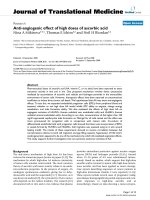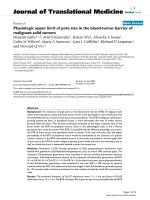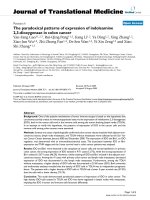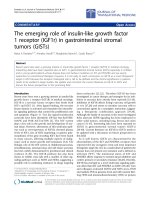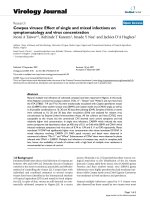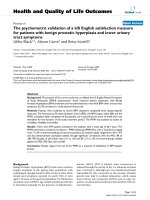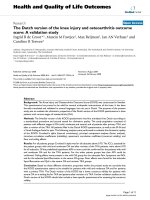báo cáo hóa học:" The Photodynamic Effect of Different Size ZnO Nanoparticles on Cancer Cell Proliferation In Vitro" docx
Bạn đang xem bản rút gọn của tài liệu. Xem và tải ngay bản đầy đủ của tài liệu tại đây (532.04 KB, 9 trang )
NANO EXPRESS
The Photodynamic Effect of Different Size ZnO Nanoparticles
on Cancer Cell Proliferation In Vitro
Jingyuan Li
•
Dadong Guo
•
Xuemei Wang
•
Huangping Wang
•
Hui Jiang
•
Baoan Chen
Received: 1 February 2010 / Accepted: 5 April 2010 / Published online: 16 April 2010
Ó The Author(s) 2010. This article is published with open access at Springerlink.com
Abstract Nanomaterials have widely been used in the
field of biological and biomedicine, such as tissue imaging,
diagnosis and cancer therapy. In this study, we explored the
cytotoxicity and photodynamic effect of different-sized
ZnO nanoparticles to target cells. Our observations dem-
onstrated that ZnO nanoparticles exerted dose-dependent
and time-dependent cytotoxicity for cancer cells like
hepatocellular carcinoma SMMC-7721 cells in vitro.
Meanwhile, it was observed that UV irradiation could
enhance the suppression ability of ZnO nanoparticles on
cancer cells proliferation, and these effects were in the
size-dependent manner. Furthermore, when ZnO nanopar-
ticles combined with daunorubicin, the related cytotoxicity
of anticancer agents on cancer cells was evidently
enhanced, suggesting that ZnO nanoparticles could play an
important role in drug delivery. This may offer the possi-
bility of the great potential and promising applications of
the ZnO nanoparticles in clinical and biomedical areas like
photodynamic cancer therapy and others.
Keywords ZnO nanoparticle Á SMMC-7721 Á
Photodynamic cancer therapy (PDT) Á Size effect Á
Drug delivery
Introduction
With the development of nanotechnology, nanomaterials
are receiving increasing interest in the relative research
and industrial applications for their unique characteristics.
As one of the most important application, nanomaterials
are now widely studied and applied in biological and
biomedical field [1–6]. Nanoscale materials, such as
nanoparticles [7–9], nanorods [10], nanowires [11, 12],
nanotubes [13] and nanofiber [14, 15], have been
explored in many biomedical applications because of
their novel properties, such as the high volume/surface
ratio, surface tailorability and multifunctionality [7–10,
16–18]. Moreover, the intrinsic optical [19, 20], magnetic
[21, 22] and biological properties of nanomaterials offer
remarkable opportunities to study and regulate complex
biological processes for biomedical applications in an
unprecedented manner [23–25]. Fundamentally, life itself
is a collective of processes at nanoscale within cells
[15, 26].
Nanoparticles (NPs) and nanosized objects are being
incorporated rapidly into clinical medicine and particularly
into the field of medical oncology [27]. As the energy
donor, quantum dots have the possibility for energy
transfer between quantum dot particles and cell molecules
such as active oxygen and give them a potential to induce
generation of reactive oxygen species and/or free radicals
and to provoke apoptosis of the cells [28, 29]. The dual
nature of UV-mediated cytotoxicity of quantum dots and
their energy donor capacity could open a new area of
quantum dot application in biology and medicine, as novel
photosensitizers or at least as potentiators of the conven-
tional photosensitizing drugs in photodynamic therapy
(PDT) of cancer. Some reports have shown that some kinds
of quantum dots (QDs) can act as photosensitizers and
Electronic supplementary material The online version of this
article (doi:10.1007/s11671-010-9603-4) contains supplementary
material, which is available to authorized users.
J. Li Á D. Guo Á X. Wang (&) Á H. Wang Á H. Jiang
State Key Lab of Bioelectronics (Chien-Shiung WU
Laboratory), Southeast University, 210096 Nanjing,
People’s Republic of China
e-mail:
B. Chen
Department of Hematology, Zhongda Hospital, Southeast
University, 210009 Nanjing, People’s Republic of China
123
Nanoscale Res Lett (2010) 5:1063–1071
DOI 10.1007/s11671-010-9603-4
potentiators of classical photosensitizers to overcome the
limitations of organic dye-based PDT [30–32].
In this study, we initially investigated the effect of dif-
ferent-sized ZnO nanoparticles on cytotoxicity of hepato-
cellular carcinoma cells (SMMC-7721). Combined with
the MTT (3-(4,5-dimethylthiazol-2-yl)2,5-diphenyl-tetra-
zolium bromide) assay, real-time cell electronic sensing
(RT-CES) study and fluorescence microscope image, we
explored the nanoparticles’ cytotoxicity for human cancer
cells in vitro and compared the distinction of different size
ZnO nanoparticles affecting the cell proliferation. As the
good photocatalysis material, the photodynamic effect of
these different-sized ZnO nanoparticles has also been
investigated by combination with UV irradiation, which
could be further utilized as a good photosensitizer with the
potential application in PDT. Meanwhile, the synergetic
cytotoxicity of the anticancer agent daunorubicin (DNR)
with ZnO nanoparticles was explored to inhibit the cancer
cell proliferation in vitro, and the real-time cell electronic
sensing (RT-CES) assay also provided the dynamic process
and binding behavior between cells and related agents.
Experimental
Reagents and Materials
Three different-sized ZnO nanoparticles capped with
aminopolysiloxane, i.e., ZP5, ZP6 and ZP7, were pur-
chased from Jiangsu Changtai Nanometer Material Co.,
Ltd. The average diameters of ZP5, ZP6 and ZP7 were
about 20, 60 and 100 nm, respectively, observed by
transmission electron microscopy (TEM) using a JEOL
JEM-2100 transmission electron microscope. Daunorubicin
was purchased from Farmitalis Co. Italian. MTT was
purchased from Sigma (USA), and all other agents were
analytical pure.
Cell Culture
SMMC-7721 cancer cells (purchased from Shanghai
Institutes for Biological Sciences, Chinese Academy of
Sciences) were maintained in RPMI-1640 medium (Gibco,
USA) supplemented with 10% fetal bovine serum (Sigma,
USA), 100 U/ml penicillin (Sigma, USA) and 100 lg/ml
streptomycin (Sigma, USA) and grown at 37°Cina5%
CO
2
humidified environment.
MTT Assay for the Proliferation of SMCC 7721
The effect of different size ZnO nanoparticles’ concentra-
tions on SMMC-7721 cancer cells was observed by MTT
assay. The final concentrations of ZnO nanoparticles were
1.56, 3.12, 6.25, 12.5, 25 and 50 lg/mL, respectively.
Initially, 1 9 10
4
cells were seeded into each well con-
taining 200 lL cell culture mediums in 96-well plate and
incubated for 24 h and then added the relevant materials
and incubated at 37°C with 5% CO
2
for 72 h. Then, 20 lL,
5 mg/mL MTT solution was added into the well and con-
tinue cultured for about 4 h. The culture medium was
discarded, and 200 lL DMSO was added following the
shaking about 10 min. The UV absorption was measured at
490 nm. Controls were cultivated under the same condi-
tions without addition of ZnO nanoparticles. The relevant
experiments were repeated thrice independently. The
inhibition efficiency (%) was expressed as follows:
(1-[A]
test
/[A]
control
) 9 100, where [A]
test
and [A]
control
represent the optical density at 490 nm for the test and
control experiments, respectively.
The Effect of UV Irradiation for the Proliferation
of SMCC 7721 in the Presence of ZnO Nanoparticles
The procedure of cell culture and treatment of nanoparti-
cles was similar with the above phase of MTT assay. Upon
application of UV irradiation, the UVC (k = 254 nm) was
provided by a germicidal lamp in the clean bench, and its
average intensity is 0.1 mW/cm
2
at the working plane. The
effect of different-sized ZnO nanoparticles for SMMC
7721 cell proliferation in the presence of UV irradiation for
180 s has been explored by MTT assay. Every experiment
was repeated at least three times independently.
In Vitro RT-CES Cytotoxicity Assay for SMMC-7721
Proliferation
The cell culture condition, the starting cell number, and cell
culture medium volume used for the 169 sensor device were
similar to that of MTT assay. Different size ZnO nanopar-
ticles were seeded in the plate with the concentration of 2.5,
5.0, and 10.0 lg/mL, respectively. Then, the effect of UV
irradiation was studied by using MTT assay. In order to study
the synergistic cytotoxicity of ZnO nanoparticles and DNR,
DNR was introduced into the system as the negative control
with concentration about 1.0 9 10
-7
mol/L. The correlative
controls were also seeded in the same plate simultaneously.
Once the cells were added to the sensor wells, the sensor
devices were placed into the incubator, and the real-time cell
index (CI) data acquisition was initiated by the RT-CES
analyzer (ACEA Bioscience. Inc. USA).
Olympus IX71 Inverted Fluorescence Microscopy
The experiment was performed as described in the litera-
ture [33]. The SMMC-7721 cells were seeded on the
coverslips in six-well plates (1 9 10
5
cells/well) and
1064 Nanoscale Res Lett (2010) 5:1063–1071
123
cultured for 24 h at 37°C with 5% CO
2
, then daunorubicin
with 1.0 9 10
-5
mol/L and different size ZnO nanoparti-
cles with 2.5 lg/mL were injected to the cells system.
Meanwhile, the cells treated with the same concentration of
solvent were taken as control experiments. All specimens
were subsequently incubated for 1 h at 37°Cwith5%CO
2
,
and quickly washed with PBS, followed by fixation with
4% formaldehyde for 5 min. Finally, specimens were
observed by inverted fluorescence microscopy (Olympus
IX71, Japan).
Statistics
Data were expressed as the mean ± SD (standard devia-
tion) from at least three independent experiments. One-
tailed unpaired Student’s t-test was used for significance
testing, and P \ 0.05 is considered significant.
Results and Discussion
Cytotoxicity of Different-Sized ZnO Nanoparticles
for SMMC7721 Cancer Cells
It is already known that the unique properties and size
effect of semiconductor nanomaterials may play an
important role in the possible biomedical application,
especially in the photodynamic therapy (PDT). In this
contribution, we have explored the cytotoxic effect of ZnO
nanoparticles, named ZP5, ZP6 and ZP7 with the average
diameters of about 20, 60 and 100 nm, as shown in the
supporting information, on SMMC-7721 cancer cells.
According to the MTT results, as shown in Fig. 1, it was
observed that the cytotoxicity was in a dose-dependent
manner, which was similar with the literature report [34].
The relevant IC50 values of ZP5, ZP6 and ZP7 nanopar-
ticles’ cytotoxicity on SMMC7721 cell lines were about
27.01, 36.60 and 21.70 lg/mL, respectively (shown in
Fig. 1). From the viability and the values of IC50, we
observe that there was no apparent difference in the cyto-
toxicity between the different size ZnO nanoparticles.
Besides, our observations demonstrate that although these
ZnO nanoparticles can greatly inhibit cancer cell prolifer-
ation in vitro at higher concentrations, they have little
effect on target cancer cells at lower concentrations.
In general, there are two mainly different actions for
nanomaterials to act toxic effects on target cells: first, a
chemical toxicity based on the chemical composition, such
as release of (toxic) ions, particle surface catalyzed reac-
tions or formation of reactive oxygen species; second, the
stress or stimuli caused by the surface, size and/or shape of
the particles [35]. In this study, three different-sized ZnO
nanoparticles could exert cytotoxic effect on SMMC-7721
cells at different concentrations. While in scale from 20 to
100 nm, there was little difference in cytotoxicity at the
identical concentration of ZnO NPs. This is different from
some other reports, such as the cytotoxic effect of carbon-
based nanomaterials is size-dependent [36].
The Effect of Nano ZnO and UV Irradiation on SMMC
7721 Cell Proliferation
As the energy donors [28], the semiconductor nanomate-
rials could have a very important application in the pho-
todynamic therapy (PDT) for energy transfer between
quantum dot particles and cell molecules (such as triplet
oxygen, reducing equivalents and pigments). Derfus and
colleagues provoked the hypothesis that while the cyto-
toxicity of quantum dots, mediated by UV irradiation, is
harmful for normal cell viability, it may be very useful in
killing cancer cells [31, 32]. After the semiconductor,
nanomaterial is excited by the UV irradiation, the semi-
conductor nanomaterial can release the oxygen free radical/
oxyradical, and the oxyradical was considered as the main
mediator of photocytotoxicity in photodynamic therapy,
causing biomembrane oxidation and degradation.
In view of the above consideration, in this study, we
have explored the effect of UV irradiation combined with
different-sized ZnO nanoparticles to inhibit the cancer cell
proliferation. As shown in Fig. 2, after the UV irradiation
for about 180 s, the cell viability of SMMC 7721 was
apparently decreased. According to the curves, we can find
that this decrease was also enhanced when the nano ZnO
concentration was increased, following the dose-dependent
manner. After UV irradiation, the related IC 50 values were
16.74, 13.17 and 8.58 lg/mL, respectively (as shown in
Fig. 3). So, these three different-sized ZnO nanoparticles
could exert remarkable inhibition effect on SMMC 7721
cells proliferation under UV irradiation compared to
that without UV irradiation, demonstrating that ZnO
0 1020304050
20
40
60
80
100
ZP
ZP ZP
ZP5
ZP6
ZP7
Cell Viability/%
Concentration of ZnO NPs/
μ
g/mL
A
B
I C50 of diferent
ZnO NP
Fig. 1 a Cell viability of SMMC-7721 cells at various concentrations
of different-sized ZnO nanoparticles. Error bars indicate standard
deviation. b The comparison of IC 50 values for different-sized ZnO
NPs
Nanoscale Res Lett (2010) 5:1063–1071 1065
123
nanoparticles could greatly exert cancer cell-killing effect
under UV irradiation, and this effect was in the dose-
dependent manner.
Based on the effect of different-sized ZnO nanoparticles
in the absence/presence of UV irradiation on SMMC 7721
cell lines, it was evident that all these ZnO nanoparticles
have the similar inhibition capacity on target cancer cells,
and UV irradiation could greatly enhance this inhibition
effect on SMMC-7721 cells in vitro when treated with ZnO
nanoparticles. These observations demonstrated that in this
nano-scale level, ZnO nanoparticles could play an impor-
tant role in inhibiting cancer cell proliferation, and UV
irradiation can further enhance this effect. It was consid-
ered that the light excites the photosensitizing agent,
resulting in formation of ROS, believed to be responsible
for the cascade of cellular and molecular events in which
the following result is selective tumor destruction [37].
After UV irradiation, nano-sized ZnO particles could effi-
ciently induce the formation of ROS and further attack the
cell membrane (mainly by lipid peroxidation), proteins
(such as enzyme deactivation) or even nucleic acids. And
the attack of the photogenerated ROS on the cell membrane
can lead to the membrane destruction, then results in the
changes in the permeability on the target cell membrane,
which causes the efflux of cytoplasm and the apoptosis or
death of the target caner cells [28, 29, 32].
The RT-CES Dynamic Study for the Inhibition
of ZnO Nanoparticles on SMMC-7721 Cancer Cells
in the Presence of UV Irradiation
The real-time cell electronic sensing (RT-CES) assay could
provide dynamic information to identify the interaction
between target cells and reagents. The basic principle of
the RT-CES system is to monitor the changes in electrode
impedance induced by the interaction between testing cells
and electrodes, where the presence of the cells will lead to
an increase in the electrode impedance. The more cells
attached to the sensor, the higher the impedance that could
be monitored with RT-CES. The RT-CES array has been
proven to be a valuable and reliable way for real-time
monitoring of dynamic changes induced by cell-chemical
interaction [38–41]. Since the relevant test is labeling free,
the RT-CES assay allows real-time, automatically and
continually monitoring cellular status changes during the
whole process of the cell-chemical interaction. Thus, in this
work we introduced the RT-CES assay to study the
dynamic response of target cancer cells exposure to ZnO
nanoparticles.
As shown in Figs. 4, 5 and 6, our observations demon-
strate that when the ZnO nanoparticles were injected into
the cell system, the electrode impendence would be lower
compared with that of negative system in the absence of
20
40
60
80
100
0
20
40
60
80
100
∗
Cell Viability/%
ZP5 NPs/μg/mL
1.56 25
without UV irradiation
UV irradiation (180 sec)
Cell Viability/%
Time/h
20
40
60
80
100
0
20
40
60
80
100
∗
Cell Viability/%
ZP6 NPs/
μ
g/mL
1.56 25
without UV irradiation
UV irradiation (180 sec)
Cell Viability/%
Time/h
01020304050
0 1020304050
01020304050
20
40
60
80
100
0
20
40
60
80
100
∗
Cell Viability/%
ZP7 NPs/μg/mL
1.56
25
without UV irradiation
UV irradiation (180 sec)
Cell Viability/%
Time/h
AB
D
FE
C
Fig. 2 Cell viability of SMMC-7721 cancer cells treated with
different concentrations of different-sized ZnO NPs in the presence
and absence of UV irradiation. a Target cancer cells treated with ZP5
NPs and b the comparison of cell viability in different ZP5 NPs
concentration with/without UV irradiation; c Target cancer cells
treated with ZP5 NPs and d the comparison of cell viability in
different ZP6 NPs concentration with/without UV irradiation; e
Target cancer cells treated with ZP5 NPs and f the comparison of cell
viability in different ZP7 NPs concentration with/without UV
irradiation
ZP5 ZP6 ZP7
0
10
20
30
40
∗
∗
∗
IC 50
Fig. 3 The comparison of IC 50 values of three different-sized ZnO
NPs for SMMC 7721 cytotoxicity in the presence and absence UV
irradiation
1066 Nanoscale Res Lett (2010) 5:1063–1071
123
0 102030405060708090100
0
2
4
6
8
Normalized Cell Index
Time/h
a
b
c
d
Treatment
2.5 5 10
0
20
40
60
80
100
without UV
with UV
Derease of cell activity/%
Concentration of ZP 5 NPs/
μg/mL
AB
Fig. 4 Dynamic response of SMMC-7721 cells exposure to ZP5 ZnO
nanoparticles. a in the absence of UV irradiation: a ZnO nanoparticle-
free (control), b 2.5 lg/mL of ZnO nanoparticles, c 5.0 lg/mL of
ZnO nanoparticles and d 10.0 lg/mL of ZnO nanoparticles; b The
comparison of decrease for cell activity in the absence/presence of
UV (irradiated for 180 s) after ZP 5 NPs was incubated in the cell
system for about 72 h
0
2
4
6
8
Treatment
Normalized Cell Index
Time/h
a
b
c
d
0 102030405060708090100 2.5 5 10
0
20
40
60
80
100
without UV
with UV
Derease of cell activity/%
Concentration of ZP 6 NPs/
μg/mL
AB
Fig. 5 Dynamic response of SMMC-7721 cells exposure to ZP6 ZnO
nanoparticles. a in the absence of UV irradiation: a ZnO nanoparticle-
free (control), b 2.5 lg/mL of ZnO nanoparticles, c 5.0 lg/mL of
ZnO nanoparticles and d 10.0 lg/mL of ZnO nanoparticles; b The
comparison of decrease for cell activity in the absence/presence of
UV (irradiated for 180 s) after ZP 6 NPs was incubated in the cell
system for about 72 h
0
2
4
6
8
Treatment
Normalized Cell Index
Time/h
a
b
c
d
0 10 20 30 40 50 60 70 80 90 100 2.5 5 10
0
20
40
60
80
100
without UV
with UV
Derease of cell activity/%
Concentration of ZP 7 NPs/
μg/mL
AB
Fig. 6 Dynamic response of SMMC-7721 cells exposure to ZP7 ZnO
nanoparticles. a in the absence of UV irradiation: a ZnO nanoparticle-
free (control), b 2.5 lg/mL of ZnO nanoparticles, c 5.0 lg/mL of
ZnO nanoparticles and d 10.0 lg/mL of ZnO nanoparticles; b The
comparison of decrease for cell activity in the absence/presence of
UV (irradiated for 180 s) after ZP 7 NPs was incubated in the cell
system for about 72 h
Nanoscale Res Lett (2010) 5:1063–1071 1067
123
nanoparticles, in which the electrode impedance became
higher following the culture time. And this decrease
affected by nanoparticles was also dose dependent and time
dependent. Compared with the results of different size
nanoparticles’ effects as shown in Figs. 3a, 4a and 5a, we
can find that there was no any notable difference. These
results were coherent with that of our MTT assay.
Furthermore, when ZnO nanoparticles were stimulated
by the UV irradiation for about 180 s, we can notice that
the electrode impendence was extremely decreased, caused
by the caner cells massive death in a short culture time
(shown in Supporting Information). Compared with
Figs. 3b, 4b and 5b, we can find that when ZP 5 ZnO
nanoparticles sized about 20 nm were only about 2.5 lg/
mL, the electrode impedance evidently decreased about
more than 80% comparing with the negative control
because of the massive death of SMMC-7721. And there
was no evidently size-dependent manner for 20 nm ZnO
nanoparticle in the cytotoxicity of cell proliferation. For ZP
6 ZnO nanoparticles sized about 60 nm, there was a
decrease of about 40% after 72-h incubation with the
nanoparticle concentration about 2.5 lg/mL, and the
decrease of the electrode impedance would be more than
95% when the concentration was about 5.0 and 10.0 lg/
mL, respectively. As the ZP 7 ZnO nanoparticles sized
about 100 nm, there was a decrease about 40% in about
2.5 lg/mL and about 63% decrease in about 5.0 lg/mL.
And there was an extremely decrease when ZP 7 was about
10.0 lg/mL. As shown in Fig. 7, the comparison of cell
inhibition for different-sized and different concentration
ZnO NPs in the absence/presence of UV irradiation indi-
cates that UV irradiation could enhance the suppression
ability of ZnO nanoparticles on cancer cells proliferation.
More importantly, this cytotoxicity for SMMC-7721 pro-
liferation caused by ZnO nanoparticles after UV irradiation
was in the size-dependent manner, i.e., the smaller the
related nanoparticle size, the higher the cytotoxicity of
cancer cell proliferation.
0
20
40
60
80
Derease of cell activity/%
(2.5)
(5.0)
(10)
0
20
40
60
80
Derease of cell activity/%
Concentration of ZnO NPs/μg/mL
(ZP5)
(ZP6)
(ZP7)
0
20
40
60
80
100
Derease of cell activity/%
(2.5)
(5.0)
(10)
ZP5 ZP6 ZP7 2.5 5 10
ZP5 ZP6 ZP7
2.5 5 10
0
20
40
60
80
100
Derease of cell activity/%
Concentration of ZnO NPs/μg/mL
(ZP5)
(ZP6)
(ZP7)
A
B
D
C
Fig. 7 a Decrease of cell index
after different concentration
ZnO NPs was incubated in the
cell system for about 72 h
without UV irradiation.
b Comparison of cell inhibition
for different-sized ZnO NPs in
the absence of UV irradiation.
c Decrease in cell index after
different concentration ZnO
NPs was incubated in the cell
system for about 72 h with UV
irradiation for 180 s.
d Comparison of cell inhibition
for different-sized ZnO NPs in
the presence of UV irradiation
for 180 s
0 102030405060708090100
0
2
4
6
8
Treatment
Normalized Cell Index
Time/h
a
b
c
d
Fig. 8 Dynamic response of SMMC-7721 cells exposure to daunoru-
bicin (1.0 9 10
-7
mol/L) with ZP5 NPs. a negative control (ZnO
nanoparticle-free); b daunorubicin (1.0 9 10
-7
mol/L); c 2.5 lg/mL
of ZnO NPs and daunorubicin (1.0 9 10
-7
mol/L) and d 5.0 lg/mL of
ZnO NPs and daunorubicin (1.0 9 10
-7
mol/L). The information of
ZP6 and ZP7 was shown in the supporting information
1068 Nanoscale Res Lett (2010) 5:1063–1071
123
The Synergistic Effect of ZnO Nanoparticles
for Daunorubicin Cytotoxicity
To further explore the bio-application of ZnO nanoparticles
in the PDT, we have combined the nano ZnO with dau-
norubicin (DNR), a widely used clinical chemotherapeutic
agent, to study the possible synergistic effect. As shown in
Fig. 8 as well as in the supporting information, our
studies indicate that when there was only daunorubicin
(1.0 9 10
-7
mol/L) in the cell system, the dynamic
response of SMMC-7721 cancer cells gradually grew with
the increase in the culture time, and the electrode impen-
dence increased correspondingly. While ZnO nanoparticles
with different concentrations were injected into the DNR
drug system, the electrode impendence is observed to
apparently decrease. It is noted that when the nanoparticles
concentration was only 2.5 lg/mL, the electrode imped-
ance decreased apparently. Especially, after the related
treatment by combining DNR with nano ZnO for about
10 h, the electrode impendence would have the apparent
decrease and the effect of nanoparticle size was not very
notable.
If the ZnO nanoparticles were irradiated by UV light,
the generated ROS made the membrane destruction which
may cause the efflux of cytoplasm and/or make more
daunorubicin molecules enter into cancer cells and induce
Fig. 9 Inverted fluorescence
micrographs of SMMC-7721
cells after incubation with a
cells only; b daunorubicin; c
ZP5 ZnO nanoparticles;
d ZP5 ZnO nanoparticles and
daunorubicin; e ZP6 ZnO
nanoparticles; f ZP6 ZnO
nanoparticles and daunorubicin;
g ZP7 ZnO nanoparticles; h ZP7
ZnO nanoparticles and
daunorubicin. Here, the
concentration of daunorubicin is
1.0 9 10
-5
mol/L, bar 20 lm
Nanoscale Res Lett (2010) 5:1063–1071 1069
123
the target cell killing. So, ZnO nanoparticles could play an
important role to enhance the synergistic cytotoxicity of
daunorubicn in the target cancer therapy, or the ZnO
nanoparticles may act as the role of drug delivery carries.
Moreover, as a widely used clinical chemotherapeutics
agent in cancer therapy, daunorubicin has the good char-
acteristic of fluorescence, suggesting that it can be used in
the fluorescence microscope image of the target cancer
cells. As shown in Fig. 9, if there was only daunorubicin in
the cell system, the excited fluorescence was not strong.
However, when the combination of daunorubicin and ZnO
nanoparticles was injected into the cell system, the excited
fluorescence in cancer cells was extremely enhanced, and
there was no any difference between the different size ZnO
nanoparticles, which was coherent with the above studies
of MTT and RT-CES. So, it is obvious that ZnO nano-
particles could play an important role in the drug delivery
to carry daunorubicin into the target caner cells thus
enhance the drug accumulation and strengthen the drug
cytotoxicity to restrain SMMC-7721 cells proliferation.
This raises the possibility to utilize ZnO nanoparticles as
one of the efficient photosensitizers in cancer PDT, which
may also provide other promising application in biological
and biomedical engineering.
In summary, our studies demonstrate that the relevant
ZnO nanoparticles play an important role as the nano-sized
drug carries. Semiconductor fluorescent NPs could be
developed for simultaneous detection and localization of
multiple solid cancer biomarkers, enabling the personali-
zation of therapeutic regimens for each patient [29, 42].
Additionally, inorganic NPs can be readily conjugated with
tumor-specific ligands and used for tumor-selective deliv-
ery of chemotherapeutic or hormonal agents [20, 22].
Meanwhile, it was observed that all these three different
size ZnO nanoparticles could have effective proliferation
inhibition capacity on target cancer cells, and UV irradia-
tion could greatly enhance the inhibition effect on target
cancer cells in vitro. The possible process for cellular
cytotoxicity of ZnO nanoparticles and daunorubicin in the
PDT could be illustrated in Scheme 1, suggesting that ZnO
particles could play an important role in the drug delivery
to enhance the accumulation and the synergistic cytotox-
icity of daunorubicin in the target SMMC-7721 cells.
Conclusion
In this contribution, our observations demonstrate that
different-sized ZnO nanoparticles exposed to SMMC-7721
cancer cells could exert dose-dependent cytotoxicity sup-
pression in vitro, and this cytotoxicity of nanoparticles was
time depended and dose depended, while the size-depended
effect was not clear in the scope from 20 to 100 nm. UV
irradiation could readily enhance the proliferation sup-
pression ability of ZnO nanoparticles on cancer cells. More
importantly, these effects were size dependent, while the
smaller the nanoparticle size, the higher the cytotoxicity of
cancer cell proliferation caused by ZnO nanoparticle.
Meanwhile, if ZnO nanoparticles combined with dauno-
rubicin, cytotoxicity of DNR for SMMC-7721 cancer cells
was especially enhanced. These observations suggest that
ZnO nanoparticles could play an important role in the PDT
and have the great potential and promising applications in
clinical and biomedical engineering.
Acknowledgments This work is supported by National Natural
Science Foundation of China (90713023, 20675014 and 20535010),
National Basic Research Program of China (No. 2010CB732404), the
Chinese Ministry of Science and Technology (2007AA022007 and
2008DFA51180) and the Natural Science Foundation of Jiangsu
Province (BK2008149).
Open Access This article is distributed under the terms of the
Creative Commons Attribution Noncommercial License which per-
mits any noncommercial use, distribution, and reproduction in any
medium, provided the original author(s) and source are credited.
References
1. J.H. Gao, B. Xu, Nano Today 4, 37–51 (2009)
2. L.N. Lewis, Chem. Rev. 93, 2693–2730 (1993)
3. M. Yezhelyev, R. Yacoub, R. O’Regan, Nanomedicine 4, 83–103
(2009)
4. C. Xiao Liu, Nano Biomed. Engine 1(1), 1–18 (2009)
5. J.J. Ji, J. Ruan, D.X. Cui, Nano Biomed. Engine 2(1), 100–128
(2010)
6. Z. Wang, J. Ruan, D.X. Cui, Nanoscale Res. Lett. 4(7), 593–605
(2009)
Scheme 1 The schematic image of ZnO nanoparticle cytotoxicity
and the PDT process cooperated with daunorubicin in vitro
1070 Nanoscale Res Lett (2010) 5:1063–1071
123
7. F.R. Tian, A. Prina-Mello, G. Estrada, A. Beyerle, W. Mo
¨
ller, H.
Schulz, W. Kreyling, T. Stoeger, Nano Biomed Eng. 1(1), 19–38
(2009)
8. D.X. Cui, Y.D. Han, Z.M. Li, H. Song, K. Wang, R. He, B. Liu,
H.L. Liu, C. Bao, P. Huang, J. Ruan, F. Gao, H. Yang, H.S. Cho,
Q.S. Ren, D.L. Shi, Nano Biomed. Eng. 1(1), 94–112 (2009)
9. T. Wang, Y. Hu, L. Zhang, L. Jiang, Z. Chen, N.Y. He, Nano
Biomed. Eng. 2(1), 46–61 (2010)
10. S.H. Chen, Y.X. Ji, Q. Lian, Y.L. Wen, H.B. Shen, N.Q. Jia,
Nano Biomed. Eng. 2(1), 19–31 (2010)
11. S.L. Bechara, A. Judson, K.C. Popat, Biomaterials 31(13), 3492–
3501 (2010)
12. R. Bellamkonda, T. John, B. Mathew, M. DeCoster, H. Hegab,
D.J. Davis, Micromech. Microeng. 20(2), 1–6 (2010)
13. D.F. Chen, X.B. Wu, J.X. Wang, B.S. Han, P. Zhu, C.H. Peng,
Nano Biomed. Eng. 1(1), 119–129 (2010)
14. C.L. He, L. Zhang, H.S. Wang, F. Zhang, X.M. Mo, Nano Bio-
med. Eng. 2(1), 91–99 (2009)
15. Y.Q. Li, Z.Y. Li, X.P. Zhou, P. Yang, Nano Biomed. Eng. 2(1),
32–45 (2010)
16. S. Hong, P.R. Leroueil, E.K. Janus, J.L. Peters, M.M. Kober,
M.T. Islam, B.G. Orr, J.R. Baker, M.B. Holl, Bioconjugate Chem.
17, 728–734 (2006)
17. A. Mecke, D.K. Lee, A. Ramamoorthy, B.G. Orr, M.B. Holl,
Biophys. J. 89, 4043–4050 (2005)
18. H. Park, S. Lee, L.X. Chen, E.K. Lee, S.Y. Shin, Y.H. Lee, S.W.
Son, C.H. Oh, J.M. Song, S.H. Kang, J. Choo, Phys. Chem.
Chem. Phys. 11, 7444–7449 (2009)
19. B.R. Fisher, H.J. Eisler, N.E. Stott, M.G. Bawendi, J. Phys.
Chem. B. 108, 143–148 (2004)
20. M. Everts, V. Saini, J.L. Leddon, R.J. Kok, M. Stoff-Khalili,
M.A. Preuss, C.L. Millican, G. Perkins, J.M. Brown, H. Bagaria,
D.E. Nikles, D.T. Johnson, V.P. Zharov, D.T. Curiel, Nano. Lett.
6, 587–591 (2006)
21. X.M. Lin, C.M. Sorensen, K.J. Klabunde, G.C. Hadjipanayis,
Langmuir 14, 7140–7146 (1998)
22. F. Sonvico, S. Mornet, S. Vasseur, C. Dubernet, D. Jaillard, J.
Degrouard, J. Hoebeke, E. Duguet, P. Colombo, P. Couvreur,
Bioconjugate Chem. 16, 1181–1188 (2005)
23. T.M. Allen, P.R. Cullis, Science 303, 1818–1822 (2004)
24. G. Wang, T. Huang, R.W. Murray, L. Menard, R.G. Nuzzo, J.
Am. Chem. Soc. 127, 812–813 (2005)
25. L.X. Tiefenauer, G. Kuhne, R.Y. Andres, Bioconjugate Chem.
4(5), 347–352 (1993)
26. S. Mann, Angew. Chem. Int. Ed. 47, 5306–5320 (2008)
27. C.C. Bao, H. Yang, P. Sheng, H. Song, X.H. Ding, B. Liu, Y.C.
Lu, G.H. Hu, D.X. Cui, Nano Biomed. Eng. 1(1), 74–87 (2010)
28. A.R. Claap, I.L. Medintz, J.M. Mauro, B.R. Fisher, M.G. Baw-
endi, H. Mattoussi, J. Am. Chem. Soc. 126, 301–310 (2004)
29. R. Bakalova, H. Ohba, Z. Zhelev, T. Nagase, R. Jose, M. Ishik-
awa, Y. Baba, Nano Lett. 4(9), 1567–1573 (2004)
30. J.B. Delehanty, K. Boeneman, C.E. Bradburne, K. Robertson, I.L.
Medintz, Expert. Opin. Drug Deliv. 6(10), 1091–1112 (2009)
31. A.M. Derfus, W.C. Chan, S.N. Bhatia, Nano Lett. 4(1), 11–18
(2004)
32. I.J. Macdonald, T.J. Dougherty, J. Porphyr. Phthalocyanines 5,
105–129 (2001)
33. A.P. Nifli, P.A. Theodoropoulos, S. Munier, C. Castagnino, E.
Roussakis, H.E. Katerinopoulos, J. Vercauteren, E.J. Castanas, J.
Agric. Food Chem. 55, 2873–2878 (2007)
34. D.D. Guo, C.H. Wu, J.Y. Li, A.R. Guo, Q.N. Li, H. Jiang, B.A.
Chen, X.M. Wang, Nanoscale Res. Lett. 4, 1395–1402 (2009)
35. T.J. Brunner, P. Wick, P. Manser, P. Spohn, R.N. Grass, L.K.
Limbach, A. Bruinink, W.J. Stark, Environ. Sci. Technol. 40,
4374–4381 (2006)
36. S. Magrez, S. Kasas, V. Salicio, N. Pasquier, J.W. Seo, M. Celio,
S. Catsicas, B. Schwaller, l. Forro, Nano Lett. 6, 1121–1125
(2006)
37. T.J. Dougherty, C.J. Gomer, B.W. Henderson, G. Jori, D. Kessel,
M. Korbelik, J. Moan, Q. Peng, J Natl. Cancer Inst. 90, 889–905
(1998)
38. J.Z. Xing, L.J. Zhu, S. Gabos, L. Xie, Toxicol. In Vitro 20, 995–
1004 (2006)
39. J.Z. Xing, L. Zhu, J.A. Jackson, S. Gabos, X.J. Sun, X.B. Wang,
X. Xu, Chem. Res. Toxicol. 18, 154–161 (2005)
40. J. Zhu, X.B. Wang, X. Xu, Y.A. Abassi, J. Immunol. Methods
309, 25–33 (2006)
41. T. Mossman, Immunol. Methods 65, 55–63 (1983)
42. Y. Matsumura, M. Gotoh, K. Muro, Y. Yamada, K. Shirao, Y.
Shimada, M. Okuwa, S. Matsumoto, Y. Miyata, H. Ohkura, K.
Chin, S. Baba, T. Yamao, A. Kannami, Y. Takamatsu, K. It, K.
Takahashi, Ann. Oncol. 15, 517–525 (2004)
Nanoscale Res Lett (2010) 5:1063–1071 1071
123
